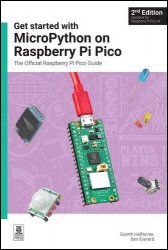Get started with MicroPython on Raspberry Pi Pico: The Official Raspberry Pi Pico Guide, 2nd Edition
- Добавил: literator
- Дата: 18-06-2024, 23:10
- Комментариев: 0
 Название: Get started with MicroPython on Raspberry Pi Pico: The Official Raspberry Pi Pico Guide, 2nd Edition
Название: Get started with MicroPython on Raspberry Pi Pico: The Official Raspberry Pi Pico Guide, 2nd EditionАвтор: Gareth Halfacree, Ben Everard
Издательство: Raspberry Pi Press
Год: 2024
Страниц: 214
Язык: английский
Формат: epub (true)
Размер: 14.2 MB
Microcontrollers, like the RP2040 chip at the heart of Raspberry Pi Pico, are computers stripped back to their bare essentials. You don't use monitors or keyboards with them — instead, you program them over USB to take their input from (and send their output to) on-board input/output pins.
Using these programmable connections, you can light LEDs, make noises, send text to screens, and much more. In Get started with MicroPython on Raspberry Pi Pico 2nd Edition, you will learn how to use the beginner-friendly MicroPython language to write programs, and you’ll connect up hardware to make your Raspberry Pi Pico interact with the world around it. Using these skills, you can create your own electromechanical projects, whether for fun or to make your life easier.
Raspberry Pi Pico is a miniature marvel, putting the same technology that underpins everything from smart home systems to industrial factories in the palm of your hand. Whether you’re looking to learn about the MicroPython programming language, take your first steps in physical computing, or want to build a hardware project, Raspberry Pi Pico — and its amazing community — will support you every step of the way.
Raspberry Pi Pico and Pico W are microcontroller development boards. They’re designed for experimenting with physical computing using a special type of processor: a microcontroller. The size of a stick of gum, Raspberry Pi Pico and Pico W pack a surprising amount of power thanks to the chip at the centre of the board: an RP2040 microcontroller.
Raspberry Pi Pico and Pico W aren’t designed to replace Raspberry Pi, which is an entirely different class of device known as a single-board computer. You might use Raspberry Pi to play games, write software, or browse the web. Raspberry Pi Pico is designed for physical computing projects, where it is used to control anything from LEDs and buttons to sensors, motors, and even other microcontrollers.
Throughout this book you’ll be learning all about Raspberry Pi Pico, but the skills you learn will also apply to any other development board based around its RP2040 microcontroller — and even other devices, so long as they are compatible with the MicroPython programming language.
Fully updated for Raspberry Pi Pico W and the latest version of MicroPython, this book shows you how to:
Get started with Raspberry Pi Pico and Pico W
Work with various electronic components
Create your own programmable electronic contraptions
Turn Raspberry Pi Pico W into a network-connected node for the Internet of Things
Link your Pico W to your smartphone, tablet, or another Pico W with Bluetooth Low Energy (BLE)
Whether you’re using Raspberry Pi Pico for a home project, industrial automation, or learning (or teaching!) electronics and programming, this book will show you how.
Contents:
Скачать Get started with MicroPython on Raspberry Pi Pico: The Official Raspberry Pi Pico Guide, 2nd Edition
Внимание
Уважаемый посетитель, Вы зашли на сайт как незарегистрированный пользователь.
Мы рекомендуем Вам зарегистрироваться либо войти на сайт под своим именем.
Уважаемый посетитель, Вы зашли на сайт как незарегистрированный пользователь.
Мы рекомендуем Вам зарегистрироваться либо войти на сайт под своим именем.
Информация
Посетители, находящиеся в группе Гости, не могут оставлять комментарии к данной публикации.
Посетители, находящиеся в группе Гости, не могут оставлять комментарии к данной публикации.

